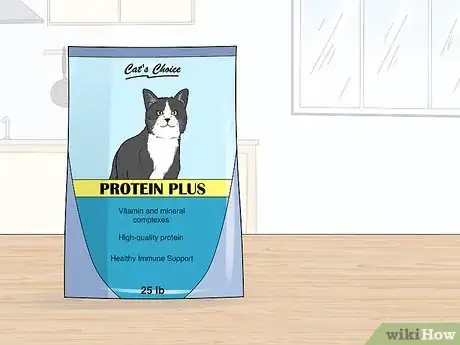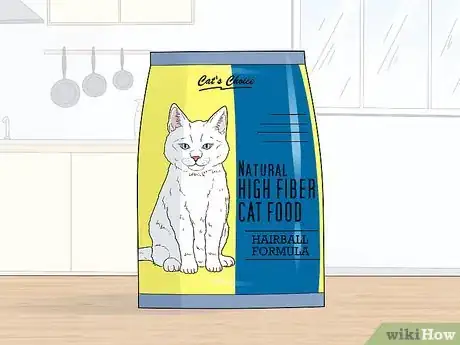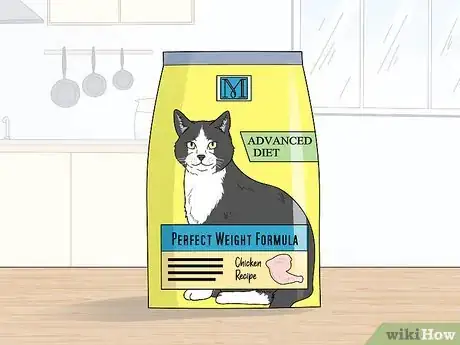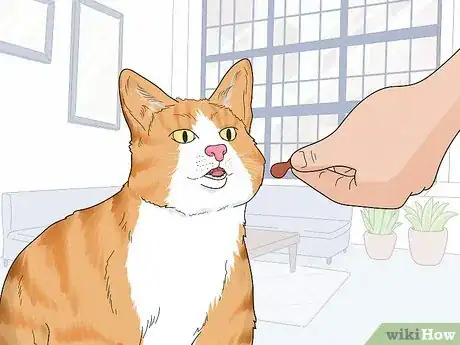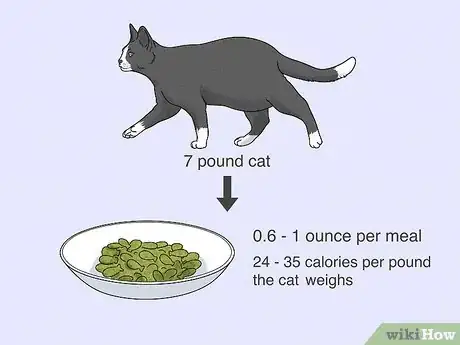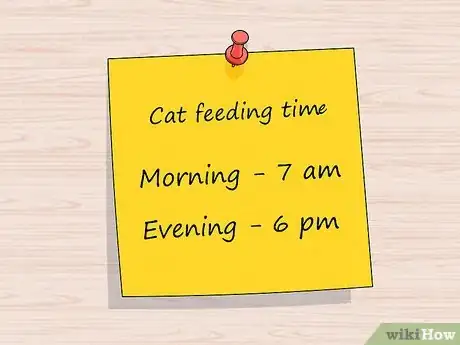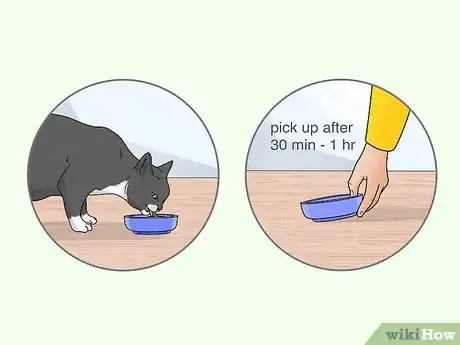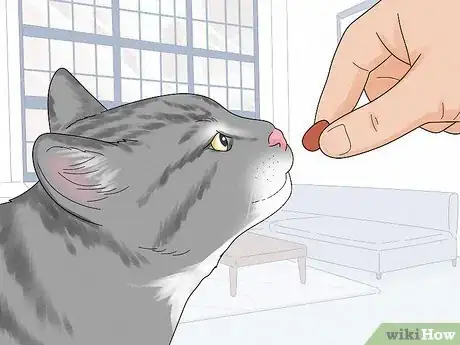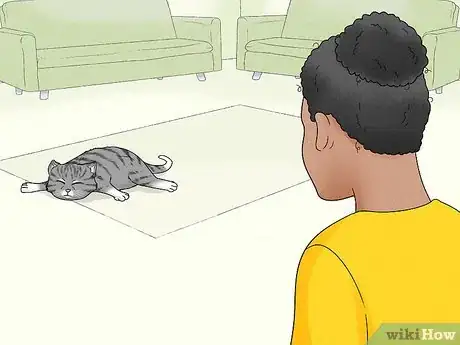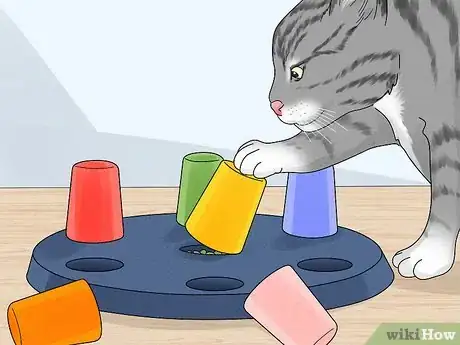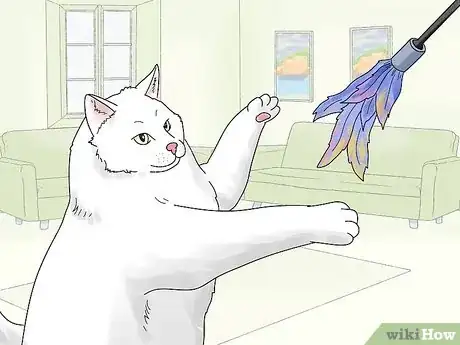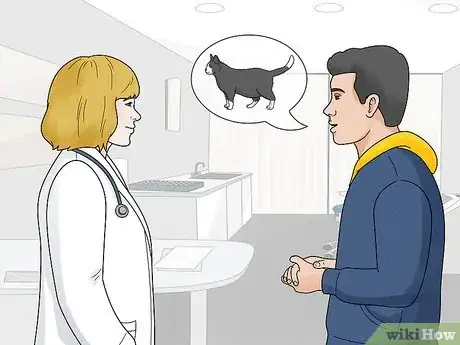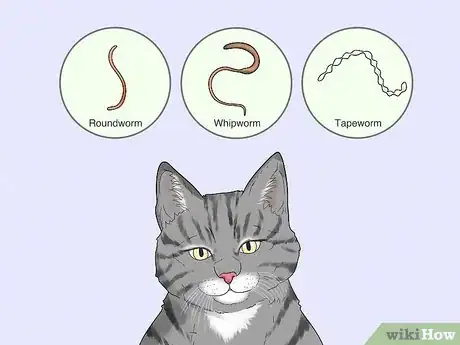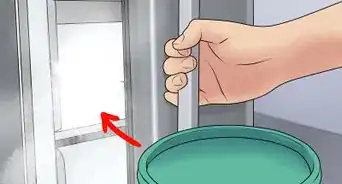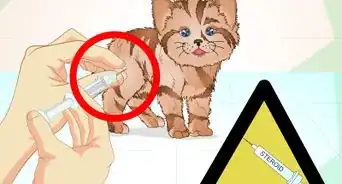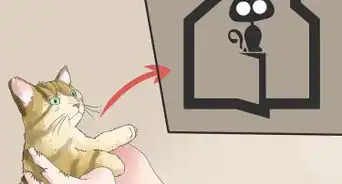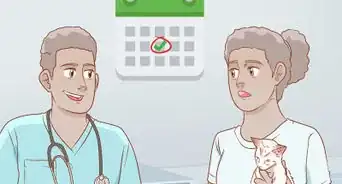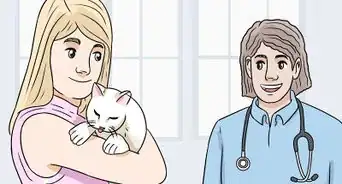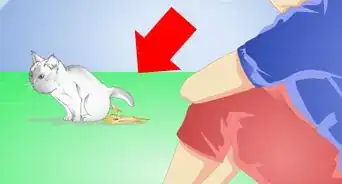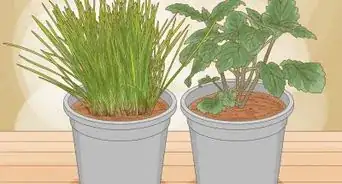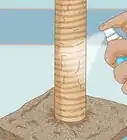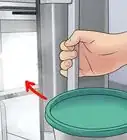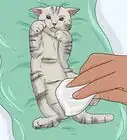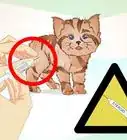This article was co-authored by Pippa Elliott, MRCVS. Dr. Elliott, BVMS, MRCVS is a veterinarian with over 30 years of experience in veterinary surgery and companion animal practice. She graduated from the University of Glasgow in 1987 with a degree in veterinary medicine and surgery. She has worked at the same animal clinic in her hometown for over 20 years.
There are 14 references cited in this article, which can be found at the bottom of the page.
This article has been viewed 18,174 times.
Feeding your cat the right amount can mean the difference between keeping up their health and allowing them to become overweight. Feeding an overweight cat in a manageable way can be accomplished by a combination of choosing the right food and right schedule for meals.[1] [2] If these don't make a positive change, it may be time to consider behavioral causes and/or visit your veterinarian.
Steps
Choosing a Food
-
1Use dry or canned food. This can affect price for the owner and palatability for the cat.[3] [4]
- Dry food is usually cheaper than canned (wet) food, and stays fresh longer.
- You need to put out more water for dry food diets.
- Canned cat food contains more water—about 70-80 percent of the food is water. But it tends to be more palatable for a cat so makes it more likely the cat will overeat.
- You can mix in bits of dry and canned food if your cat seems to like both as long as it’s getting enough to eat per meal.
-
2Get a cat food that’s high in protein. Since cats are carnivores, they need to consume a lot of protein in order to be healthy. Make sure that whatever cat food you buy is at least 35% protein.
- Fats and carbohydrates combined shouldn’t make up more than 50% of your cat’s diet.[5]
Advertisement -
3Give your cat a high fiber cat food to help with appetite control. There’s a chance that your cat is overweight because it keeps eating and eating and doesn’t feel full. To avoid this issue, look for a cat food that’s high in fiber. High fiber cat food contains a bulking agent that will make your cat feel full faster.
- Fiber also helps to break down hairballs.[6]
-
4Select a diet cat food. There are some cat foods that better balance their ingredients to help cats lose weight.[7]
- Crash dieting is bad for a cat and can result in a disorder can occur called hepatic lipidosis.
- Instead you should work with your veterinarian to select a feeding regimen to help your cat manage their eating habits and nutrition to lose the weight gradually.
- Get an initial weight of the cat and over three to four weeks add increasing portions of the selected feline weight-loss diet food to the cat’s dish.
- Mix the new diet food in with the old food so the cat gets used to the change.
- Notice how much the cat eats daily.
- The cat should be weighed after four week intervals. If there is no change or an increase in weight then the portion of overall food needs to be decreased. If there is too much weight loss (more than half a pound in just four weeks), or the cat has stopped eating for 2 or more days, then there could be a more serious illness at work and you need to consult your veterinarian.
-
5Use treats sparingly. Treats can be good for your cat for a variety of functions from helping with their coat to improving their mood. But too many can add weight.[8]
- Treats should make up no more than 10 percent of your cat’s daily calories.
- Avoid giving treats too close to the cat’s feeding time so they eat their regular cat food and don’t miss out on their essential nutrients.
-
6Measure meal portions. If you don’t want to use a diet cat food you can try using standard cat foods in more controlled portions.[9] [10] [11]
- This will take a bit more effort to measure the amount of food you are putting into the cat’s food dish for each feeding especially if you leave it in the dish all day
- Look at the pet food’s suggested daily amount and divide it into two servings to be given 8 to 12 hours apart.
- Another rule of thumb would be if you have a 7 pound cat then they need to have 1/25th the meal size of a human or 0.6 to 1 ounce of food per meal. This also could be thought of as 24-35 calories per pound the cat weighs per day.
- The portions may vary a bit with your cat’s individual needs. Consult with your veterinarian if you are unsure.
-
7Add new food gradually. If you are going to attempt to introduce a diet cat food or supplement to the cat’s usual food you need to do it slowly.[12]
- Try to keep the same food dish as it is a safety signal to the cat.
- Offer new food alongside the old food so the cat can try it. If it won’t eat it then you can try something else. If it likes the new food then you can gradually increase the new food until it replaces the old.
Scheduling Feeding Times
-
1Set out the right number of meals per day. This can vary with age of your cat.[13] [14]
- For adult (aged 1 year to 11 years) or senior cats (aged 11 or older) meals should be set out twice or once per day.
- If you are feeding twice per day then set the meals out 8 to 12 hours apart. Use the portion control steps from earlier.
-
2Feed the cat at the same time. Keeping the cat on the same feeding schedule will help when changing its diet.[15]
- Keeping consistent with feeding times will help calm the cat and acclimate it to changes with food.
- If you feed in the late morning and late evening then don’t change.
- Try not to start feeding the cat at times you know will be hectic for you and risks you forgetting to put food out.
-
3Try feeding the cat at timed intervals. Leave the food out a certain amount of time and then pick it up.[16]
- If you are feeding the cat once or twice a day you need to leave the meal out long enough to give it a chance to eat.
- To avoid the cat over indulging pick the meal up after a reasonable time limit—30 minutes to 1 hour.
-
4Give treats infrequently. Just as the treats should make up only a small portion of calories for a cat they need to be given only a few times in addition to meals.[17]
- Avoid giving treats near meal time and space them out to two or three times per week so they remain fun and novel for the cat.
- Even if the cat is overweight you should not cut out treats completely, but consult your veterinarian for how you can keep them in the cat’s diet at a reduced amount.
Assessing and Addressing Behavioral Issues
-
1Identify your cat’s boredom or depression. Your cat may be overweight because it’s overeating. Overeating is one of the many signs that a cat is bored and/or depressed. To assess whether your cat is bored or depressed, observe your cat to find the answers to these questions:
- Is your cat over grooming itself?
- Is your cat chasing and/or fighting other household pets?
- Is your cat extremely inactive/lazy?
- Does your cat seemed disheartened or disinterested in the things going on around it?[18]
-
2Use puzzle toys to mentally stimulate your cat. One way to entertain and challenge your cat is by putting its food in a puzzle toy. These require that the cat earns its meal by testing it mentally. Using these toys can greatly stimulate your cat and decrease its feelings of boredom or depression.[19]
-
3Entertain your cat with interactive playtime. For a cat, life inside a home can be much more humdrum than life in the wild. Get a couple of toys that your cat might find exciting, such as a laser pointer or a plastic rod with a feather on the end. Play with your cat for at least a few minutes each day to satisfy its hunting instincts and to keep it active. This will help prevent boredom, depression, and obesity.[20]
Consulting with Your Veterinarian
-
1Report extreme changes in your cat’s weight to your veterinarian. If the cat’s weight has changed more than a half pound within a four week period then you need to see a veterinarian.[21]
- This could be a sign of a nutritional imbalance or more complicated illness.
- Look for signs of change in appetite and drinking habits as well.
- If the cat has not eaten in 48 hours then seek veterinarian attention as soon as possible.
-
2Ask your veterinarian about portion changes. The portions will change with a cat’s individual needs.[22] [23] [24]
- The veterinarian can help you adjust the portions for your cat’s weight and other conditions such as diabetes or infection.
- Work with the veterinarian to treat your cat’s other conditions in conjunction with weight control.
-
3Inquire about testing your cat for worms. If you notice that your cat is eating excessively and seems to be gaining weight, consider testing it for worms. Worms absorb the nutrition in food before the cat has the chance to, which may be making your cat want to overeat. Parasites have a “swelling” effect on the body, and so your cat may look overweight as a result. If you suspect that your cat has worms, take a fecal sample to your vet to get it tested.[25]
Warnings
- Do not use dog food or dog diet pills on a cat. Both are harmful for cats.⧼thumbs_response⧽
- Using raw food you prepare yourself for a cat’s diet can risk bacterial contamination or nutritional imbalance.⧼thumbs_response⧽
- Cats cannot digest carbohydrates.⧼thumbs_response⧽
- Overweight cats more likely to need care for lameness, skin conditions, diabetes, and death in middle age (6-12 years of age).⧼thumbs_response⧽
- Spaying or neutering a cat can cause hormone changes that affect metabolism and/or activity—eventually causing weight changes in a cat.⧼thumbs_response⧽
- If your cat has complications from another illness (such as diabetes) make sure nutrition isn’t sacrificed during treatment before you deal with changing their diet. Consult your veterinarian about changes.⧼thumbs_response⧽
- Only use cat supplements and vitamins to correct deficiencies under your veterinarian’s guidance.⧼thumbs_response⧽
- Don’t hit the cat as punishment.⧼thumbs_response⧽
References
- ↑ https://www.vet.cornell.edu/departments-centers-and-institutes/cornell-feline-health-center/health-information/feline-health-topics/how-often-should-you-feed-your-cat
- ↑ http://pets.webmd.com/cats/guide/healthy-weight-for-your-cat
- ↑ https://www.vet.cornell.edu/departments-centers-and-institutes/cornell-feline-health-center/health-information/feline-health-topics/how-often-should-you-feed-your-cat
- ↑ http://pets.webmd.com/cats/guide/feeding-your-adult-cat-what-you-need-to-know?page=2
- ↑ http://www.petmd.com/cat/nutrition/evr_ct_obesity_in_cats_and_what_to_do_about_an_overweight_cat?page=2
- ↑ http://www.catological.com/cat-food/
- ↑ http://www.petmd.com/cat/nutrition/evr_ct_obesity_in_cats_and_what_to_do_about_an_overweight_cat?page=4
- ↑ http://pets.webmd.com/cats/guide/feeding-your-adult-cat-what-you-need-to-know?page=4
- ↑ http://pets.webmd.com/cats/guide/feeding-your-adult-cat-what-you-need-to-know?page=3
- ↑ http://www.petmd.com/cat/nutrition/evr_ct_obesity_in_cats_and_what_to_do_about_an_overweight_cat?page=2
- ↑ http://pets.webmd.com/cats/guide/mistakes-people-make-feeding-cats
- ↑ http://pets.webmd.com/cats/guide/healthy-weight-for-your-cat?page=3
- ↑ https://www.vet.cornell.edu/departments-centers-and-institutes/cornell-feline-health-center/health-information/feline-health-topics/how-often-should-you-feed-your-cat
- ↑ http://pets.webmd.com/cats/guide/feeding-your-adult-cat-what-you-need-to-know?page=3
- ↑ https://www.vet.cornell.edu/departments-centers-and-institutes/cornell-feline-health-center/health-information/feline-health-topics/how-often-should-you-feed-your-cat
- ↑ http://pets.webmd.com/cats/guide/feeding-your-adult-cat-what-you-need-to-know?page=3
- ↑ http://pets.webmd.com/cats/guide/cat-food-101-what-you-need-to-know-about-feeding-your-cat?page=2
- ↑ http://www.pawculture.com/tips-advice/cat-behavior/6-signs-your-cat-is-bored/
- ↑ http://www.catster.com/lifestyle/why-your-cat-is-eating-constantly
- ↑ http://pets.webmd.com/cats/features/keeping-indoor-cat-happy#1
- ↑ http://www.petmd.com/cat/nutrition/evr_ct_obesity_in_cats_and_what_to_do_about_an_overweight_cat?page=4
- ↑ http://pets.webmd.com/cats/guide/feeding-your-adult-cat-what-you-need-to-know?page=3
- ↑ http://www.petmd.com/cat/nutrition/evr_ct_obesity_in_cats_and_what_to_do_about_an_overweight_cat?page=2
- ↑ http://pets.webmd.com/cats/guide/mistakes-people-make-feeding-cats
- ↑ http://www.catster.com/lifestyle/why-your-cat-is-eating-constantly

